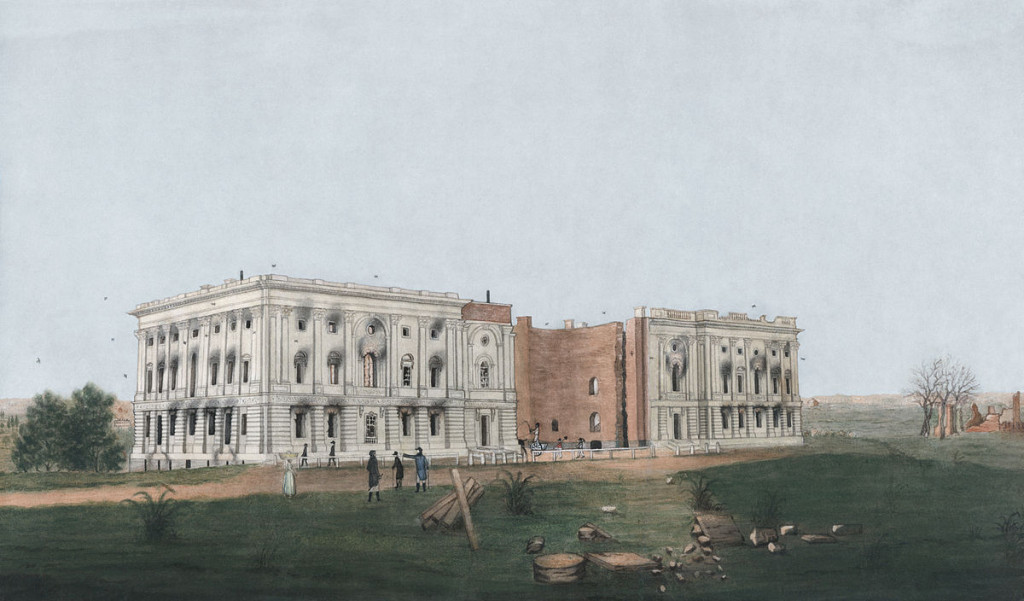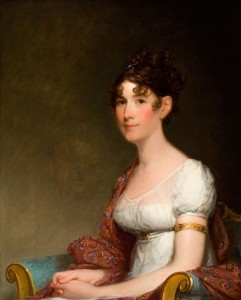By Cassandra Good, Associate Editor, Papers of James Monroe
On an unusually warm March afternoon two hundred years ago, James Monroe took the oath of office as America’s fifth president. In a capital city still recovering from having government buildings burned to the ground three years earlier by the British, large crowds thronged the city to celebrate Monroe’s inauguration on March 4, 1817. The planning of the ceremony itself caused a congressional squabble, the oath was taken under a temporary portico outside of a temporary capitol building, and nobody could hear Monroe’s speech. But that day ushered in a brief era of national unity and good feeling, when Americans formed (in Monroe’s words) “one great family with a common interest.”
James Monroe entered the presidency with more experience in elected or appointed office than any man before—or since. Born on Virginia’s Northern Neck in 1758, he had joined the Continental Army to fight in the Revolution as a teenager and been in public service almost continually since. As James Madison’s Secretary of State, he was seen as the natural successor to his long-time friend. He won election handily in 1816 against Federalist Rufus King, taking 84% of the electoral votes. It was a rare moment of near-unity after the bruising partisan bickering of the previous three decades, with the opposition Federalist party largely collapsing and power consolidating under Monroe’s Democratic Republicans.
Monroe planned, in keeping with tradition, a simple inauguration ceremony on the regular date of March 4. He wrote to both the Senate, which would host the inauguration, and Chief Justice Marshall, who would swear him in, of his plans on March 1. He stated that he would take the oath at noon in the chamber of the House of Representatives. A committee of senators then planned the specifics, determining where the president, leaders of the House and Senate, Supreme Court justices, heads of departments, and ambassadors would sit. The “fine red chairs” of the Senate chamber would be carried to the House chamber for the dignitaries. The audience would comprise senators at the front, behind them members of the House, and finally other selected men and women invited to attend. Officers would be appointed to keep the public from entering.
When the senators notified the House of Representatives of their plans, however, the representatives revolted. House Speaker Henry Clay of Kentucky wrote the senate committee mid-day on March 3, declaring that that the Senate “had not, as a body, a right to regulate the Hall of Representatives or to arrange the furniture thereof, or to introduce other furniture into it, without the concurrence of the House of Representatives.” In recalling the incident years later, Clay explained that he preferred the House chamber’s “plain democratic chairs” to the Senate’s fancier red seats. Apparently the two sides could not come to an agreement on room arrangements, and late that evening the Senate committee concluded they would hold the ceremony outside. The committee members sent a quick note to the diplomatic corps letting them know, which the ambassadors took to mean there would be no seats or formal role for them.
The next morning dawned with unseasonably warm temperatures and weather that was “extremely fine and exhilarating.” The sky was clear and the air still; as one attendee noted, “not an unruly breeze ruffled the plaits of the best handkerchief.” Vice President Daniel Tompkins arrived at the Monroes’ rented home at 2017 I St (several blocks from the White House), and the men left the house at 11:30 a.m. They were accompanied by a group of citizens on horseback, and they travelled down Pennsylvania Avenue to the temporary U.S. Capitol Building. Dubbed the Old Brick Capitol, the building stood across First Street (now the site of the Supreme Court) from the burned Capitol building and it housed the Senate and House from 1815 to 1819. Just before noon, Tompkins and Monroe entered the building with James Madison and the Supreme Court Justices for Tompkins’ swearing in in the Senate Chamber, as he was ceremonial leader of that body. Tompkins gave a short speech, and then the party moved outdoors for the day’s big event.
Outside of the building was a hastily-erected portico, with seats for the diplomatic corps to one side and the department heads on the other. The former sat empty, as the ambassadors did not know until afterward that there were in fact reserved seats for them and chose not to attend. Local military units were there, however, as was an audience of both ladies and gentlemen.
The crowd was gathered in carriages to watch the ceremony, but its size is hard to determine. A newspaper account noted that while it “was impossible to compute with any thing like accuracy the number of carriages, horses, and persons present,” the editors estimated five to eight thousand. “Such a concourse was never before seen in Washington,” they reported. Massachusetts senator Harrison Gray Otis’s wife, Sally Foster Otis, was less impressed with the crowd. She guessed that there were fewer attendees than at Boston’s Artillery Election Day (an annual parade and election of officers for the Ancient and Honorable Artillery Company) and those at the inauguration “were by no means so well conditioned.”
There were certainly enough people that “few if any heard” Monroe give his speech and take the oath of office. Even if Monroe spoke loudly, outdoors his voice could not have travelled far. But newspapers published his optimistic and celebratory speech in its entirety.
Monroe marveled that “during a period fraught with difficulties, and marked by very extraordinary events, the United States have flourished beyond example.” The American experiment in self-government was a success, he said, calling it a “happy government” that worked because of the people. “The government has been in the hands of the people,” he noted. “To the people, therefore, and to the faithful and able depositaries of their trust is the credit due.” He went beyond an assessment of the country’s status to offer policy priorities for his administration: strengthening the country’s defences, education, roads and canals; promoting domestic manufacturing; and furthering national unity.
After his speech, Monroe took the oath of office from his old schoolmate, Chief Justice John Marshall. The conclusion of the oath was announced by an attendant waving a white flag and a single gunshot, followed by salutes from military installations around the city. Mrs. Otis was also unimpressed with the cheer that followed, reporting that “a very feeble acclamation was at length effected by A Comodore who came out with a hurra but it did not amount to a boston cheer.”
At some point during or at the conclusion of the ceremony (accounts vary), a large bird flew over the Capitol building. Many believed it was an eagle and took this as an “auspicious omen.” One letter to the editor asked what direction the eagle had flown so as to determine if it was a positive or negative omen. But Mrs. Otis again had a less favorable take: “sorry am I to say I could make neither more or less than an old Carolina acquaintance a Turkey buzzard.”
The ceremony completed, the new president and the attendees began to travel back down Pennsylvania Avenue to Monroe’s home for a reception. It seems that more of the crowd may have been waiting along Washington’s central thoroughfare than had attended the ceremony; Mrs. Otis described crowds “as far as the Eye could extend with carriages of every description.” The sidewalks, too, were filled with people, “men women & children fiddler fifer & drums.” Many of them followed the procession to 2017 I St, where it took Mrs. Otis almost an hour to reach the front door.
People of all walks of life entered the reception, creating a crowd that one local newspaper called “unusual.” The reporter continued, “The buz, the chat, the hurley-burley were pleasing, because hearty and good humored.” Mrs. Otis was less charitable, complaining that she and her husband had to get past “all the Scavengers & wash women of the City.” The reception appears only to have been for invited guests, but these everyday citizens “were laying violent hands on the waiters of cake & refreshments that were prepared & intended for the company.” Monroe must have been relieved to see the ambassadors at the reception, having been confused by their absence at the inauguration ceremony. Perhaps in part to placate the diplomatic corps—and furthermore to antagonize the British—he placed the French ambassador next to him at dinner.
Later that night, there was a formal inaugural ball at Davis’s Hotel on Pennsylvania Avenue and 6th St NW. This party, too, was “crowded to overflowing.” The Washington City Weekly Gazette called it a “brilliant ball” and estimated that 1,000 people attended. Beyond the ballroom, there were toasts to Monroe around the country. In Massachusetts, John Adams dined at a “festival in honour of mr Monroe” with 200 people. Even hardened Bostonian Federalists had kind feelings towards the new president, Adams told his son; “all Speak of him with Esteem, Respect and even of Affection.”
Monroe channeled this good will into an “era of good feelings” and two terms as a popular president. Only three months after his inauguration, Monroe set off on a tour of the northern states to promote national defence and unity. He built a cabinet comprised of a geographically and ideologically diverse set of men. The president, Monroe believed, “ought not to be the head of a party, but of the nation itself.” He ran unopposed for re-election in 1820 and received all but one electoral vote. Although this interlude of nonpartisanship quickly came to a close in the race to succeed him, the spectators on that sunny March day in 1817 did not know of the party realignment to come. What they witnessed was unity and optimism for the years to come in the young country.






Speak Your Mind